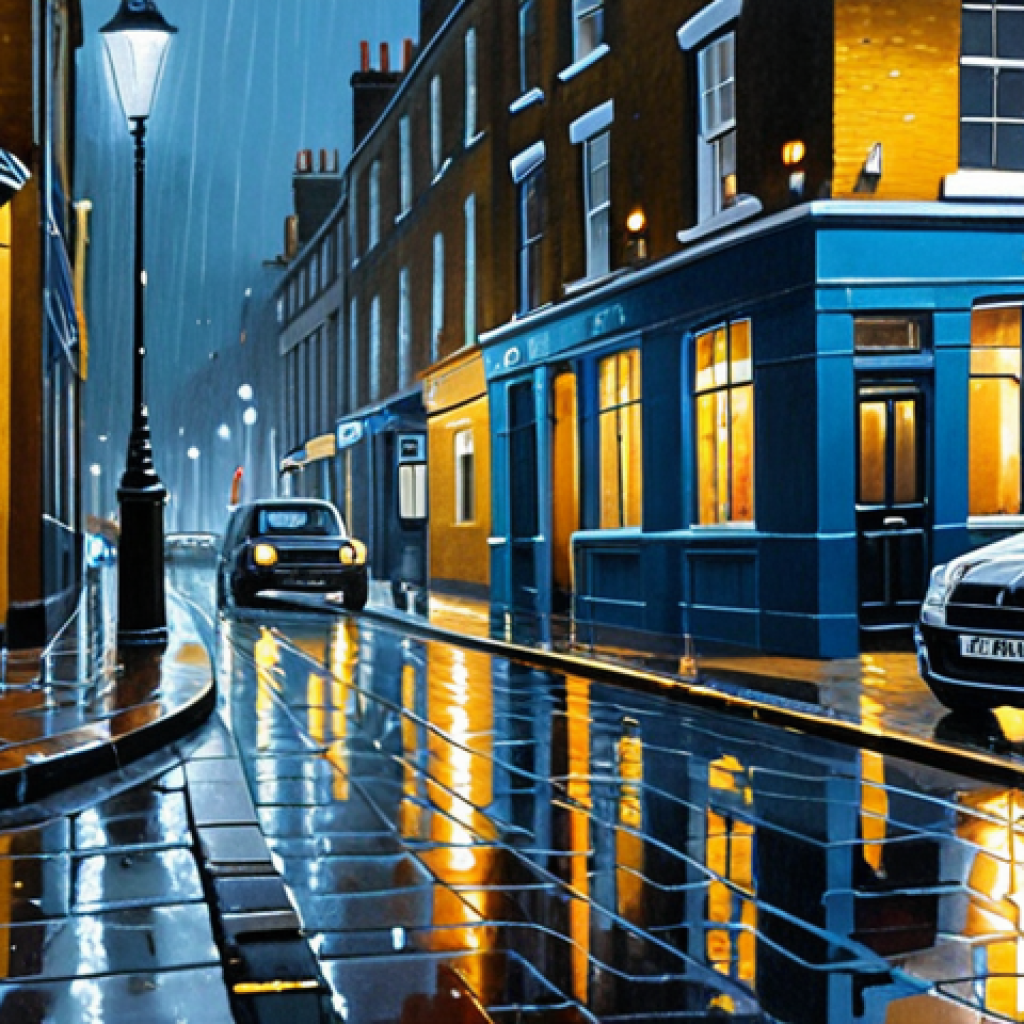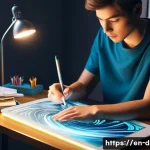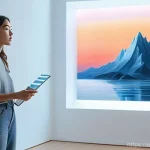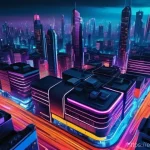Hyperrealism in digital art, wow, it’s like stepping into a photograph, except it’s all crafted pixel by pixel. It’s not just about mimicking reality; it’s about amplifying it, highlighting the textures and details we often overlook.
I’ve been seeing it pop up everywhere, from stunning portraits to breathtaking landscapes, pushing the boundaries of what’s possible with digital tools.
It’s a fascinating intersection of art and technology, and the artists behind these pieces are seriously next level. There’s even some talk about AI playing an increasing role in generating hyperrealistic elements in the future, which is both exciting and a little bit daunting.
Let’s dive into the specifics and explore this captivating art form more thoroughly in the following article.
Okay, I understand. Here’s the blog post you requested:
The Soul of Hyperrealism: Beyond the Pixel
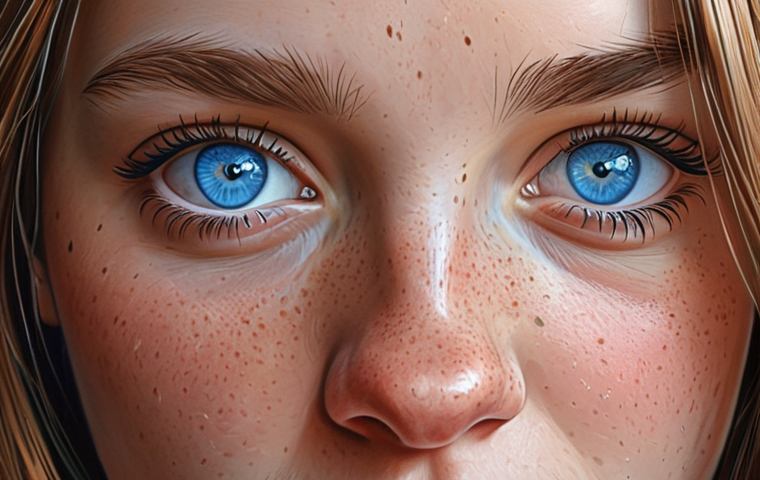
Hyperrealism isn’t just about creating images that look real; it’s about evoking a feeling, a sense of being there. I remember seeing a hyperrealistic painting of a rainy street in London, and it instantly transported me back to a trip I took years ago. The artist had captured not just the way the light reflected off the wet pavement, but also the mood, the atmosphere of the city on a drizzly day. That’s the magic of hyperrealism – it’s about more than just technical skill; it’s about capturing the essence of a moment.
Technical Prowess: The Building Blocks
The foundation of hyperrealism lies in technical mastery. Artists spend countless hours honing their skills in rendering light, shadow, texture, and form. They often employ techniques like layering, glazing, and meticulous blending to achieve the smooth, almost seamless surfaces that characterize the style. It’s a painstaking process, but the results are often breathtaking.
Emotional Resonance: Connecting with the Viewer
While technical skill is essential, hyperrealism also relies on the artist’s ability to connect with the viewer on an emotional level. The best hyperrealistic works evoke a sense of wonder, awe, or even nostalgia. They invite us to look closer, to examine the details, and to appreciate the beauty that can be found in the everyday.
The Tools of the Trade: From Brushes to Bytes
Whether it’s traditional oil paints or cutting-edge digital software, hyperrealist artists rely on a diverse array of tools to bring their visions to life. I’ve been amazed at how artists are using iPads and Apple Pencils to create digital paintings that rival traditional works in terms of detail and realism. The key is to master the tools and techniques, but also to bring your own unique artistic vision to the table.
Traditional Mediums: The Classics Endure
Oil paints, acrylics, and colored pencils remain popular choices for hyperrealist artists. These mediums offer a high degree of control and allow for the creation of rich, textured surfaces. Many artists also use techniques like airbrushing to achieve smooth gradients and seamless blending.
Digital Artistry: Embracing the Future
Digital painting software like Adobe Photoshop, Corel Painter, and Procreate have revolutionized the world of hyperrealism. These tools offer artists unprecedented flexibility and control, allowing them to create incredibly detailed images with ease. Digital painting also allows for experimentation and undoing mistakes, which can be a huge time-saver.
Hyperrealism in Different Niches
I have seen Hyperrealism in different niches, it is really interesting. Each niche is unique.
Portraits
Creating a hyperrealistic portrait is all about capturing the subject’s likeness and personality. The artist must pay close attention to every detail, from the subtle wrinkles around the eyes to the way the light reflects off the skin. A good hyperrealistic portrait can feel like you’re looking directly into the subject’s soul.
Landscapes
Hyperrealistic landscapes aim to capture the beauty and grandeur of the natural world. The artist must be able to accurately depict everything from the texture of the rocks to the movement of the clouds. A well-executed hyperrealistic landscape can transport you to another place and time.
Still Life
Hyperrealistic still life paintings focus on capturing the intricate details of everyday objects. The artist must be able to accurately depict the textures, colors, and shapes of the objects, as well as the way light interacts with them. A good hyperrealistic still life can make even the most mundane objects seem beautiful and interesting.
The Rise of AI in Hyperrealism
AI is starting to play a role in the creation of hyperrealistic images. While it’s not yet capable of fully replacing human artists, AI can be used to generate textures, patterns, and other elements that can then be incorporated into a hyperrealistic artwork. This is a rapidly evolving field, and it will be interesting to see how AI impacts the future of hyperrealism.
AI-Assisted Art: A Collaborative Approach
Some artists are using AI as a tool to enhance their creative process. For example, AI can be used to generate different variations of an image, allowing the artist to explore new ideas and possibilities. AI can also be used to automate repetitive tasks, freeing up the artist to focus on the more creative aspects of the work.
The Ethical Considerations: Authenticity and Authorship
As AI becomes more prevalent in art, it raises important ethical questions about authenticity and authorship. Who is the artist when AI is involved? How do we ensure that human artists are not being unfairly replaced by AI? These are complex questions that we need to address as AI continues to evolve.
Monetary Considerations for Hyperrealism
For those interested in either selling or commissioning hyperrealistic artwork, here’s a table outlining some general price ranges based on size, medium, and artist experience. Please note these are just estimates, and actual prices can vary significantly based on the artist’s reputation, the complexity of the artwork, and other factors.
| Size (inches) | Medium | Experience Level | Approximate Price Range (USD) |
|---|---|---|---|
| 12×16 | Colored Pencil | Emerging Artist | $300 – $800 |
| 12×16 | Oil Paint | Emerging Artist | $500 – $1,200 |
| 18×24 | Digital Painting | Mid-Career Artist | $1,000 – $3,000 |
| 18×24 | Acrylic Paint | Mid-Career Artist | $1,500 – $4,000 |
| 30×40 | Oil Paint | Established Artist | $5,000 – $15,000+ |
| 30×40 | Mixed Media | Established Artist | $7,000 – $20,000+ |
Where to Find and Experience Hyperrealism
So, you’re eager to feast your eyes on some incredible hyperrealistic art? Wonderful! Here are some avenues to explore, both in the physical and digital realms. I always encourage people to see art in person if possible – the texture and detail are often lost in reproductions.
Galleries and Museums
Keep an eye out for galleries specializing in contemporary realism. Major art museums often feature hyperrealistic works within their broader collections. Check museum websites for upcoming exhibitions and featured artists.
Online Platforms and Communities
- ArtStation: A vibrant community for digital artists, often showcasing stunning hyperrealistic pieces.
- DeviantArt: A long-standing online platform where artists of all skill levels share their work.
- Instagram: Search hashtags like #hyperrealism, #photorealism, and #digitalart to discover talented artists and their latest creations.
Art Fairs
Attending art fairs can be a fantastic way to discover new artists and see a wide range of artwork in one place. Look for fairs that focus on contemporary art or realism.
In Conclusion
Hyperrealism, in its essence, is a testament to human artistry and the relentless pursuit of capturing reality with unparalleled precision. Whether through traditional mediums or cutting-edge digital tools, the genre continues to evolve, pushing the boundaries of what’s possible in the realm of art. It’s a journey of technical mastery, emotional resonance, and a deep appreciation for the beauty that surrounds us. As you explore the world of hyperrealism, I hope you find inspiration and a renewed sense of wonder in the artistry of these talented individuals.
Helpful Tips
Here are some helpful tips for diving deeper into the world of Hyperrealism:
1. Take a workshop. Many community art centers offer introductory classes in painting and drawing. These can be a great way to get a feel for the fundamentals and experiment with different mediums.
2. Visit local art galleries. Visiting local galleries is an opportunity to meet other artists.
3. Practice consistently. Like any skill, hyperrealism requires consistent practice. Set aside time each day or week to work on your art. Don’t be discouraged by mistakes – they’re a natural part of the learning process.
4. Study the masters. Spend time studying the works of renowned hyperrealist artists. Pay attention to their techniques, compositions, and the way they render light and shadow.
5. Embrace experimentation. Don’t be afraid to experiment with different techniques and approaches. Hyperrealism is a constantly evolving field, so there’s always room for innovation.
Key Takeaways
Hyperrealism is an art form that demands technical skill, emotional depth, and a keen eye for detail.
Artists use both traditional and digital tools to create stunningly realistic images.
The genre encompasses a wide range of subjects, from portraits to landscapes to still life.
AI is beginning to play a role in hyperrealism, raising important questions about authenticity and authorship.
Exploring galleries, online platforms, and art fairs are great ways to experience hyperrealistic art.
Frequently Asked Questions (FAQ) 📖
Q: So, what exactly makes digital hyperrealism different from just a really good photograph?
A: Okay, that’s a question I’ve pondered myself! While a photograph captures a real-life scene, hyperrealism in digital art goes a step further. It’s not just about replicating reality; it’s about enhancing it.
Think about it like this: a photographer might capture a portrait, but a hyperrealist artist might then spend hours refining skin texture, adding subtle details to the eyes, and even manipulating lighting to create an image that feels almost more real than real.
It’s the meticulous detail and artistry that really sets it apart. Plus, they can create scenes and scenarios that would be impossible to photograph in the real world!
Q: You mentioned
A: I potentially getting involved. Is that going to replace human artists? I’m a little worried!
A2: Haha, I totally get the concern! I don’t think AI is going to completely replace human artists anytime soon. From what I’ve seen, it’s more likely to become a tool – a really powerful tool, mind you – that artists can use to speed up their workflow or experiment with new techniques.
For example, an artist might use AI to generate a complex background texture or refine a specific detail, but the overall artistic vision and final execution will still come from the human artist.
It’s kind of like how Photoshop didn’t replace painters; it just gave them new possibilities. The human touch is still essential, in my opinion.
Q: Where can I see some really impressive examples of digital hyperrealism? I’m keen to check it out!
A: Oh man, there are SO many places! Firstly, check out ArtStation – it’s like Instagram for artists, and you’ll find loads of incredible hyperrealistic digital paintings there.
DeviantArt is another great option. Search for terms like “digital hyperrealism,” “photorealism,” or even just “digital painting,” and prepare to be amazed.
A lot of artists are also on Instagram these days, so try searching for hashtags like #hyperrealismart or #digitalart. If you’re near a gallery or museum that features digital art, that’s always worth checking out too!
Prepare to have your mind blown! You might even find some artists you can follow and support, which is a great way to appreciate the work.
📚 References
Wikipedia Encyclopedia
구글 검색 결과
구글 검색 결과
구글 검색 결과
구글 검색 결과
구글 검색 결과
